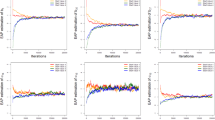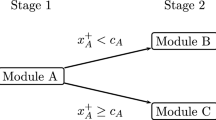Abstract
Nonresponse data are common in achievement tests or questionnaires. Chang et al. (Br J Math Stat Psychol 74:487–512, 2021) proposed an Item Response tree model, namely TR4, for modeling some potential mechanisms underlying nonresponses so that the estimates of parameters of interest would not be biased due to missing not at random (Rubin in Biometrika 63:581–592, 1976). TR4 has two notable degenerate cases, both with insightful practical meanings. When TR4 is fitted to data originated from some degenerate cases, there exist model identifiability issues so that the existing frequentist inference for the TR4 model is not suitable. In the current study, we propose a Bayesian estimation procedure that incorporates the Markov chain Monte Carlo technique for estimating the TR4 model. We conducted simulation studies to demonstrate the effectiveness of the Bayesian estimation procedure in solving the model unidentifiability issue. In addition, the TR4 model is further extended in the present study to effectively accommodate the complexity underlying some real data. The advantage of the extended models over TR4 is demonstrated in the real data analysis where we apply our method to the data of a geography test for college admission in Taiwan.







Similar content being viewed by others
Availability of data and material
The datasets analysed during the current study are provided in the supplementary materials. The copyright of the data is owned by Taiwan’s College Entrance Examination Center.
Notes
The data was provided by Taiwan’s College Entrance Examination Center. https://www.ceec.edu.tw/en/xmdoc/cont?xsmsid=0J164378162651032149.
We thank reviewers for the suggestions.
References
Adams MJD, Umbach PD (2012) Nonresponse and online student evaluations of teaching: understanding the influence of salience, fatigue, and academic environments. Res High Edu 53:576–591. https://doi.org/10.1007/s11162-011-9240-5
Azzalini A, Genz A, Miller A, Wichura MJ, Hill GW, Ge Y (2016) mnormt: The multivariate normal and t distributions, and their truncated versions. R package version 1.5-5. https://cran.r-project.org/web/packages/mnormt/
Baker FB, Kim SH (2004) Item response theory: parameter estimation techniques. CRC, Boca Raton
Bolt DM, Cohen AS, Wollack JA (2002) Item parameter estimation under conditions of test speededness: application of a mixture Rasch model with ordinal constraints. J Edu Meas 39:331–348. https://doi.org/10.1111/j.1745-3984.2002.tb01146.x
Cao J, Stokes SL (2008) Bayesian IRT guessing models for partial guessing behaviors. Psychometrika 73:209–230. https://doi.org/10.1007/s11336-007-9045-9
Celeux G, Forbes F, Robert CP, Titterington DM (2006) Deviance information criteria for missing data models. Bayesian Anal 1:651–673. https://doi.org/10.1214/06-BA122
Chang YW, Tsai R, Hsu NJ (2014) A speeded item response model: leave the harder till later. Psychometrika 79:255–274. https://doi.org/10.1007/s11336-013-9336-2
Chang YW, Hsu NJ, Tsai R (2021) An item response tree model with not-all-distinct end nodes for non-response modeling. Br J Math Stat Psychol 74:487–512. https://doi.org/10.1111/bmsp.12236
Debeer D, Janssen R, De Boeck P (2017) Modeling skipped and not-reached items using IRTrees. J Edu Meas 54:333–363. https://doi.org/10.1111/jedm.12147
Finch H (2008) Estimation of item response theory parameters in the presence of missing data. J Educ Meas 45:225–245. https://doi.org/10.1111/j.1745-3984.2008.00062.x
Fox JP (2010) Bayesian item response modeling-theory and applications. Springer, New York
Gelman A, Rubin DB (1992) Inference from iterative simulation using multiple sequences (with discussion). Stat Sci 7:457–511
Geman S, Geman D (1984) Stochastic relaxation, Gibbs distributions, and the Bayesian restoration of images. IEEE Trans Pattern Anal Mach Intell 6:721–741. https://doi.org/10.1109/TPAMI.1984.4767596
Goegebeur Y, De Boeck P, Wollack JA, Cohen AS (2008) A speeded item response model with gradual process change. Psychometrika 73:65–87. https://doi.org/10.1007/s11336-007-9031-2
Hasting WK (1970) Monte Carlo sampling methods using Markov chains and their applications. Biometrika 57:97–109. https://doi.org/10.1093/biomet/57.1.97
Holman R, Glas CAW (2005) Modeling non-ignorable missing data mechanisms with item response theory models. Br J Math Stat Psychol 58:1–18. https://doi.org/10.1111/j.2044-8317.2005.tb00312.x
Kim S, Cohen AS, Baker FB, Subkoviak MJ, Leonard T (1994) An investigation of hierarchical Bayes procedures in item response theory. Psychometrika 59:405–421. https://doi.org/10.1007/BF02296133
Lindley DV (1971) Bayesian statistics: a review. SIAM, Philadelphia
Macdonald P, Paunonen SV (2002) A Monte Carlo comparison of item and person statistics based on item response theory versus classical test theory. Educ Psychol Measur 62:921–943. https://doi.org/10.1177/0013164402238082
Martin AD, Quinn KM, Park JH, Vieilledent G, Malecki M, Blackwell M, Poole K, Reed C, Goodrich B, Ihaka R, L’Ecuyer P, Matsumoto M, Nishimura T (2019) MCMCpack: Markov Chain Monte Carlo (MCMC) Package. R package version 1.4-5. https://cran.r-project.org/web/packages/MCMCpack/
Pohl S, Gräfe L, Rose N (2014) Dealing with omitted and not-reached items in competence tests: evaluating approaches accounting for missing responses in item response theory models. Educ Psychol Measur 74:423–452. https://doi.org/10.1177/0013164413504926
R Core Team, R: A Language and Environment for Statistical Computing, R Foundation for Statistical Computing, Vienna, Austria, 2020. https://www.R-project.org/
Rubin DB (1976) Inference and missing data. Biometrika 63:581–592. https://doi.org/10.1093/biomet/63.3.581
Spiegelhalter DJ, Best NG, Carlin BP, van der Linde A (2002) Bayesian measures of model complexity and fit. J Roy Stat Soc B 64:583–616. https://doi.org/10.1111/1467-9868.00353
Swaminathan H, Gifford JA (1986) Bayesian estimation in the three-parameter logistic model. Psychometrika 51:589–601. https://doi.org/10.1007/BF02295598
Ulitzsch E, von Davier M, Pohl S (2020) A hierarchical latent response model for inferences about subject engagement in terms of guessing and item-level non-response. Br J Math Stat Psychol 73:83–112. https://doi.org/10.1111/bmsp.12188
Ulitzsch E, von Davier M, Pohl S (2020) Using response times for joint modeling of response and omission behavior. Multivar Behav Res 55:425–453. https://doi.org/10.1080/00273171.2019.1643699
Weeks JP, von Davier M, Yamamoto K (2016) Using response time data to inform the coding of omitted responses. Psychol Test Assess Model 58:671–701
Acknowledgements
We thank the editor and reviewers for valuable comments and suggestions which improve this article. We are grateful to Dr. Nan-Jung Hsu and Dr. Rung-Ching Tsai for their valuable suggestions.
Funding
Yu-Wei Chang’s research has been supported by the Ministry of Science and Technology (MOST, Taiwan) under Grant No. 106-2118-M-035-002. Yu-Wei Chang and Jyun-Ye Tu’s research has been supported by the MOST under Grant No. 107-2118-M-035-003.
Author information
Authors and Affiliations
Contributions
Yu-Wei Chang: conception and design of the work; analysis of data; the creation of new software used in the work; conducting simulations; drafted the work.
Jyun-Ye Tu: the creation of new software used in the work; conducting simulations.
Corresponding author
Ethics declarations
Conflicts of interest
The auhtor declare that they have no conflict of interest.
Code availability
The code implementing the current study is available in the supplementary materials.
Additional information
Publisher's Note
Springer Nature remains neutral with regard to jurisdictional claims in published maps and institutional affiliations.
Supplementary Information
Below is the link to the electronic supplementary material.
Appendix: Details of the Markov chain Monte Carlo procedure
Appendix: Details of the Markov chain Monte Carlo procedure
In this appendix, we present details regarding the MCMC procedure for estimating the TR4 model. The estimation procedures for the TR4-I and TR4-SI models in Sect. 4 follow directly.
At each iteration, we update three categories of parameters or variables sequentially: (i) \(V_{pj}\); (ii) parameters in \(\varvec{\zeta }_1\); (iii) hyperparameters in \(\varvec{\xi }_1\). In each full conditional, “\(|\cdots \)” denotes conditioning on all other parameters at their current values and on observed data. At the \((t+1)\)-th iteration, we update parameters and missing variables as follows.
(i) Update \(V_{pj}\):
The partially latent binary variable \(V_{pj}\) has a full conditional
According to (13), \(V_{pj}\) must be 1 when \(d_{pj}=1\). Therefore, we do not need to update \(V_{pj}\) whenever \(d_{pj}=1\). When \(d_{pj}=0\), the full conditional \(V_{pj}|\cdots \) is a Bernoulli random variable with success probability \(q_1/(q_0+q_1)\), where
(ii) Update parameters in \(\varvec{\zeta }_1\):
For the full conditional of every parameter in \(\varvec{\zeta }_1\), the posterior distribution is not a standard distribution. We develop a Metropolis–Hastings algorithm for each parameter in \(\varvec{\zeta }_1\). We first introduce the sampling scheme for \(\rho \).
The full conditional for \(\rho \in [-1,1]\) is
For a normal symmetric random walk, we first transform the \(\rho \) to the real line scale, called \(\eta \), which is the same as (7). A proposal distribution for the Metropolis–Hastings algorithm is imposed on the real line scale \(\eta \): we generate \(\eta ^*\) from the proposal \(N(\eta ^{(t)}, c_\eta )\), where \(\eta ^{(t)}=\log ((1+\rho ^{(t)})/(1-\rho ^{(t)}))\) and \(c_\eta \) is a constant to be determined empirically so that the acceptance rate in the following acceptance–rejection rule is about \(30\%{\sim }40\%\). Subsequently, \(\rho ^*\) can be obtained through \( \rho ^* = \frac{2 \exp ( \eta ^*) }{1 + \exp ( \eta ^*)}-1 \). The following acceptance–rejection rule is adopted:
According to the Metropolis–Hastings algorithm, \(\rho ^{(t+1)}\) follows \(f( \rho | \cdots )\).
The Metropolis–Hastings algorithms for other parameters in \(\varvec{\zeta }_1\) are similar to the above procedure. Basically, for a parameter whose range is \(\varvec{\mathcal {R}}\), we directly adopt a normal symmetric random walk proposal. For a parameter whose range is not the whole real line, we transform the parameter to a new scale on \(\varvec{\mathcal {R}}\) and then apply a normal random walk to the new scale. The transformations and the ratios in the acceptance–rejection rules for Metropolis–Hastings algorithms of other parameters are summarized in Table 4. The Metropolis–Hastings algorithms for \(\tau _p\), \(b_j\), and \(\gamma _{0,j}\) are the same as that for \(\theta _p\).
(iii) Update hyperparameters in \(\varvec{\xi }_1\):
The full conditional of every parameter in \(\varvec{\xi }_1\) is a commonly used distribution and can be sampled directly by using available functions in computing software such as R (R Core Team 2020). The distributions of such full conditionals are as follows:
Rights and permissions
About this article
Cite this article
Chang, YW., Tu, JY. Bayesian estimation for an item response tree model for nonresponse modeling. Metrika 85, 1023–1047 (2022). https://doi.org/10.1007/s00184-022-00858-1
Received:
Accepted:
Published:
Issue Date:
DOI: https://doi.org/10.1007/s00184-022-00858-1




